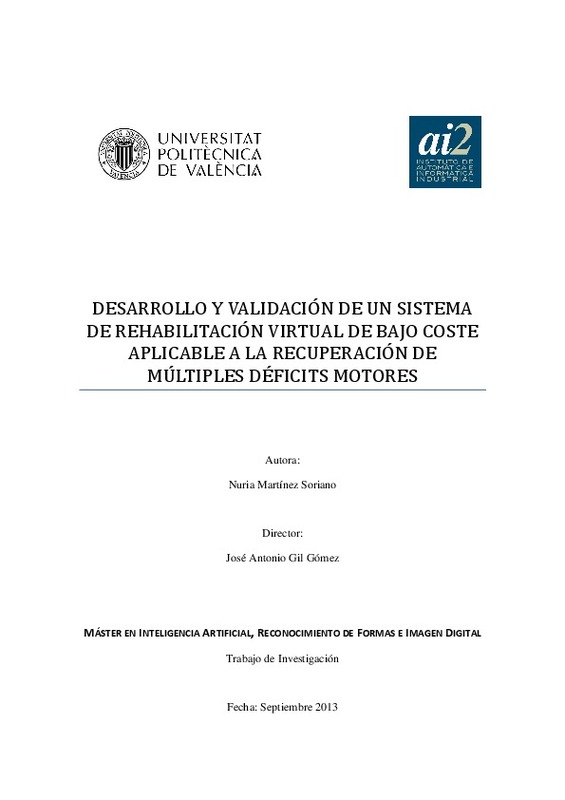|
Resumen:
|
[ES] Muchas son las personas afectadas por problemas originados por daño cerebral
adquirido, dificultando gravemente sus actividades de la vida cotidiana. Tareas tan
sencillas como coger o mover objetos pueden ser un ...[+]
[ES] Muchas son las personas afectadas por problemas originados por daño cerebral
adquirido, dificultando gravemente sus actividades de la vida cotidiana. Tareas tan
sencillas como coger o mover objetos pueden ser un reto para estas personas. Desde
hace tiempo se usa rehabilitación tradicional para ayudar a disminuir el impacto que
causan estos problemas en las personas afectadas.
La tecnología de sistemas de Realidad Virtual aplicada en el campo de rehabilitación
está en auge, generando el concepto de Rehabilitación Virtual (RHBV). Cada vez son más
los dispositivos o periféricos capaces de ser adaptados a las necesidades rehabilitadoras
para cada paciente. Algunos de los principales problemas o inconvenientes de varios
periféricos son su coste, su disponibilidad o su instalación en el entorno.
En este estudio se verá con detalle las funcionalidades del sistema de Rehabilitación
Virtual Motora desarrollado llamado ¿A la Caza del Tesoro¿ (ACT). El dispositivo
integrado que se utiliza es Microsoft Kinect¿, cuyas ventajas son su bajo coste,
disponibilidad, portabilidad y fácil adaptación en el entorno. Gracias a Kinect se le puede
aplicar al paciente un preciso sistema de tracking que permite detectar su posición y
movimiento, además de que no se necesita colocar ningún dispositivo a la persona. El
sistema ACT forma parte del sistema TAR (Technologies for Active Rehabilitation).
El objetivo de este proyecto es el desarrollo y la validación de la adecuación del
sistema ACT. Además este sistema permite, gracias al interfaz de Kinect, la posibilidad de
interactuar con distintas partes del cuerpo: cabeza, tronco, manos o pies. Por lo tanto el
especialista podrá configurar de forma personalizada para cada paciente/sesión los
parámetros acorde a su necesidad. Además de todo esto, destacar que otro de los
objetivos a cumplir es lograr la motivación personal del paciente de cara a su
rehabilitación, pues es otro de los problemas a los que se enfrentan anímicamente los
pacientes día a día.
[-]
[EN] Many people are affected by problems caused by acquired brain damage, causing
serious difficulties in their activities of daily living. Simple tasks as grabbing or moving
objects can be challenging for these people. ...[+]
[EN] Many people are affected by problems caused by acquired brain damage, causing
serious difficulties in their activities of daily living. Simple tasks as grabbing or moving
objects can be challenging for these people. Traditional rehabilitation has been used for
many years to reduce the impact caused by these problems in those affected people.
The technology of virtual reality systems applied in the rehabilitation field is booming.
In fact, it is getting the concept of Virtual Rehabilitation. Devices or peripherals are
increasingly capable of being adapted to the rehabilitative needs for each patient. One of
the main problems or disadvantages of some peripherals are their cost, their availability
or their installation on the environment.
In this study we will see in detail the features of the Virtual Motor Rehabilitation
system developed called ¿A la Caza del Tesoro¿ (ACT). The integrated device used in the
system is Microsoft Kinect¿, whose advantages are its low cost, availability, portability
and easy adaptation on the environment. Thanks to Kinect, an accurate tracking system
can be applied to the patient. This system is able to detect their position and movements
without placing any device to the person who is using Kinect. The game is part of the TAR
system (Technologies for Active Rehabilitation).
The purpose of this project is the development and validation of the adequacy of the
system ACT. Thanks to the Kinect interface, ACT allows the ability to interact with
different parts of the body, that is, the ones that the patient needs to rehabilitate: head,
trunk, hands or feet. Therefore, the specialist can configure for each patient/session
customized parameters according to their needs. Besides all this, I must highlight that
another objective of this project is to achieve the patient¿s personal motivation towards
their rehabilitation because it is another of the problems that patients emotionally face
every day
[-]
|







